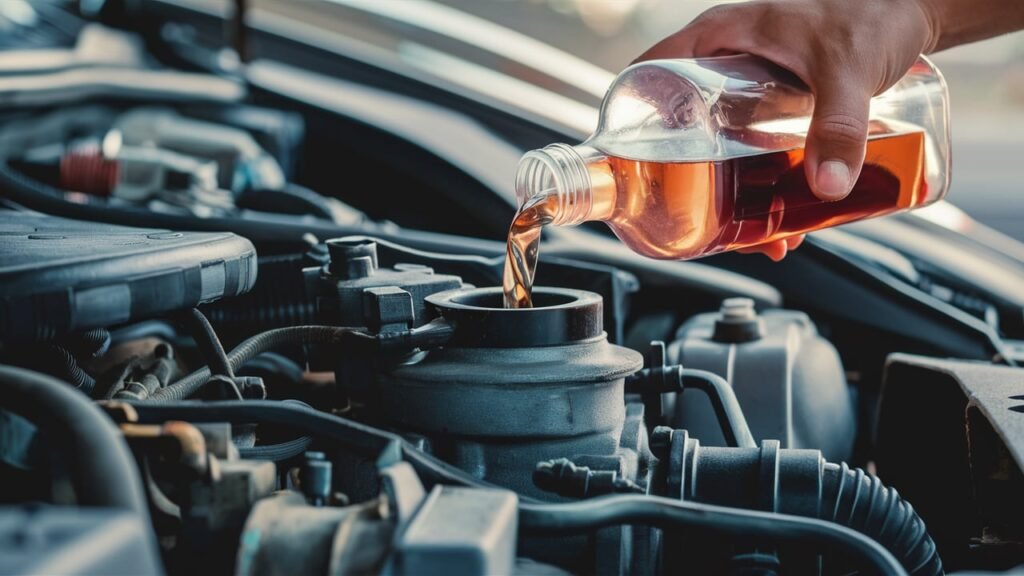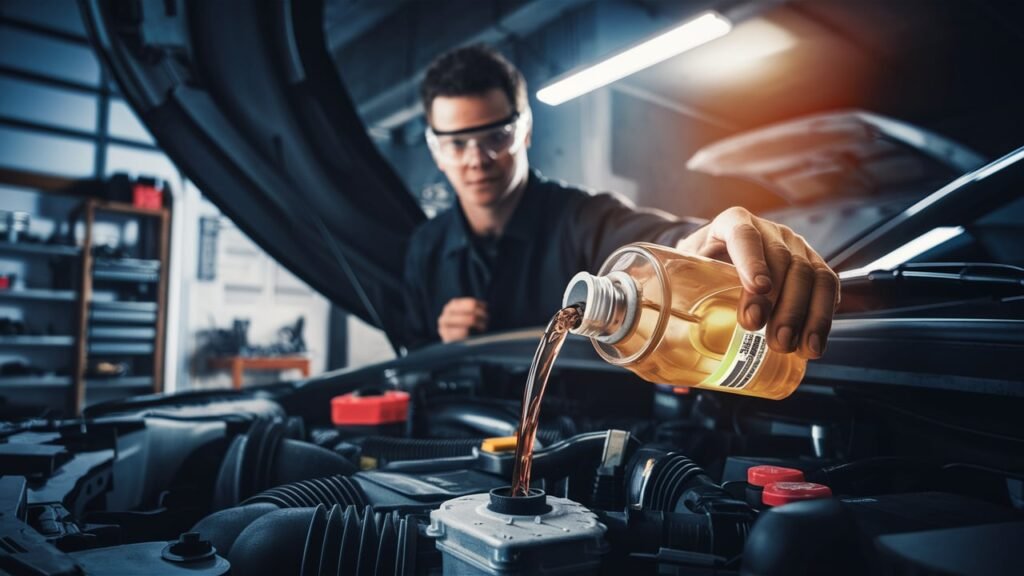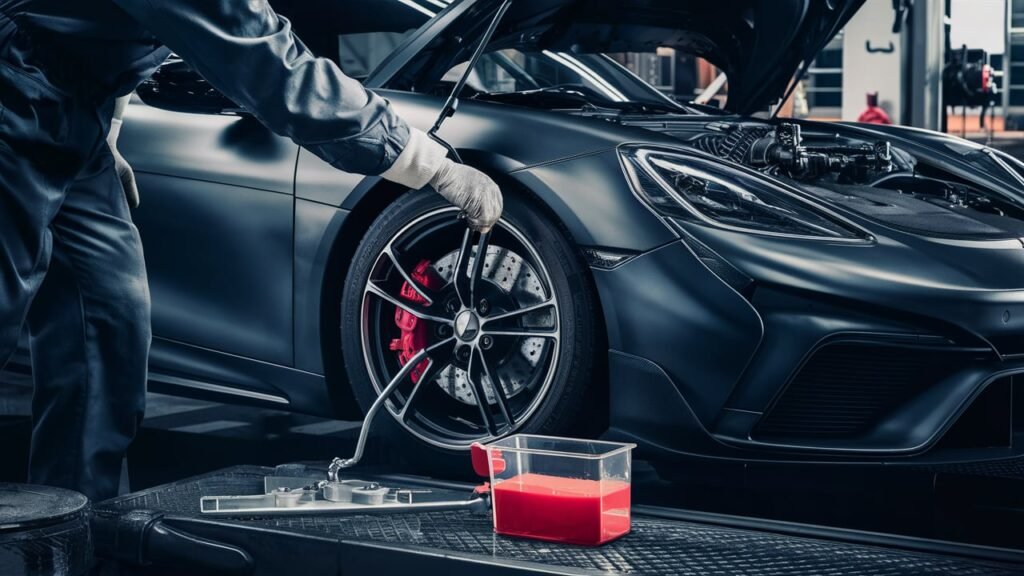
What You Need to Know About Topping Off Car Engine Brake Fluid
In the intricate dance of automotive maintenance, ensuring the precise levels of car engine brake fluid stands as a critical yet often overlooked chore. Topping off car engine brake fluid involves the meticulous task of adding this vital lubricant to maintain impeccable braking performance.
Picture it as the lifeblood that courses through your vehicle’s braking system, facilitating smooth and responsive stops in every journey. This article delves into the nuanced realm of topping off car engine brake fluid – an art form that underpins safe and efficient driving experiences.
Manifesting itself as a pivotal cog within the mechanical apparatus of your vehicle, proper levels of brake fluid are indispensable for optimal braking functionality. To neglect this fundamental duty could spell grave consequences for both driver and machine alike.
The importance of maintaining adequate brake fluid becomes apparent when one considers its role in transmitting pressure from the brake pedal to each wheel, engaging those precious calipers that bring your moving metal steed to a controlled halt.
Thus, by grasping the essence of topping off car engine brake fluid, automotive enthusiasts can safeguard their vehicles against potential hazards and ensure steadfast roadworthiness with each pressing application of the brakes.
Understanding Car Engine Brake Fluid.
Brake fluid is a critical component in a car’s braking system, responsible for transferring the force exerted on the brake pedal to the wheel brakes. Typically, brake fluid is stored in a reservoir near the master cylinder under the hood of the car.
Once you press the brake pedal, this non-compressible fluid activates the hydraulic system, amplifying your foot pressure and allowing the vehicle to slow down or stop effectively. It serves as a medium to transmit force from the brake pedal to the brake assemblies at each wheel.
There are several types of brake fluids available that cater to different vehicles and their braking systems. These include DOT 3, DOT 4, and DOT 5. Each type has its own set of characteristics such as boiling points and viscosity ratings that make them suitable for specific applications.

For instance, vehicles requiring high-performance braking may benefit from a DOT 4 or higher grade which offers increased boiling points to prevent vapor lock during intense braking scenarios.
Low brake fluid levels can lead to compromised braking performance and potentially dangerous situations on the road. Some common signs indicating low brake fluid levels include a spongy or soft brake pedal feel, illuminated dashboard warning lights related to brakes, longer stopping distances than usual, or unusual noises when applying brakes.
Regularly checking your car’s brake fluid level is crucial in maintaining optimal braking efficiency and ensuring safety on the road.
Process of Topping Off Car Engine Brake Fluid.
When it comes to safely topping off brake fluid in a car engine, following a systematic approach is crucial. Here is a step-by-step guide to help you navigate this process successfully:
1. **Identify the Reservoir:** Locate the brake fluid reservoir under the hood of your car. The reservoir is typically transparent with “MAX” and “MIN” markings, indicating the appropriate levels.
2. **Prepare the Area:** Before opening the reservoir cap, ensure the surrounding area is clean to prevent any contaminants from entering the system.
3. **Choose the Right Fluid:** Consult your vehicle’s manual to determine the correct type of brake fluid required for your car. Using an incompatible fluid can lead to damage within the braking system.
4. **Open the Reservoir:** Slowly unscrew the cap from the brake fluid reservoir but be cautious as brake fluid can damage paint surfaces if spilled.

5. **Add Fluid Carefully:** Use a funnel to avoid spillage and carefully pour in small amounts of brake fluid until reaching the “MAX” line on the reservoir.
6. **Securely Close the Cap:** Once you’ve filled up to the correct level, securely tighten the reservoir cap back in place.
In terms of tools and equipment, you will need a funnel specifically designated for brake fluid to avoid cross-contamination with other fluids or debris that may compromise braking performance. Additionally, wearing gloves and protective eyewear when handling brake fluid is advisable due to its corrosive nature.
Always remember that safety should be a top priority when dealing with brake fluid – avoid direct contact with skin and always work in a well-ventilated area to minimize exposure to potentially harmful fumes.
By following these precautions and steps diligently, you can effectively maintain proper levels of brake fluid in your car without risking safety or performance issues down the road.
When to Top Off Car Engine Brake Fluid.
Several factors can contribute to a decrease in brake fluid levels within a car’s braking system. One common reason is routine wear and tear, as the seals in the brake system age over time, potentially allowing minute amounts of fluid to escape.
Moreover, a leak in the brake lines or cylinders can also lead to a gradual reduction in brake fluid levels. It is crucial for car owners to proactively monitor their brake fluid reservoir to detect any unexpected drops in fluid volume that may signal an underlying issue.
To maintain optimal braking performance and ensure safety on the road, it is recommended that car owners check their brake fluid levels regularly. Experts suggest inspecting the brake fluid reservoir during routine maintenance intervals or every few months.

This proactive approach allows car owners to identify potential leaks or decreases in fluid levels early on, preventing any safety hazards associated with low brake fluid volume.
Temperature fluctuations play a vital role in regulating the level of brake fluid within a car’s braking system. Extreme heat can cause the brake fluid to expand, leading to a rise in pressure within the system and potentially overfilling the reservoir.
Conversely, cold temperatures can cause contraction of the brake fluid, reducing its volume and possibly creating air pockets within the system. Understanding how temperature impacts brake fluid levels enables car owners to anticipate changes and take appropriate action, such as adjusting the fluid level accordingly based on environmental conditions.
Importance of Properly Topping Off Brake Fluid.
Maintaining proper levels of brake fluid in a car is crucial for safe and efficient braking performance. Driving with low brake fluid levels can have serious consequences, including decreased braking efficiency, longer braking distances, and even complete brake failure in extreme cases.
Insufficient brake fluid can lead to air entering the hydraulic system, causing spongy or unresponsive brakes. This highlights the critical role that brake fluid plays in ensuring the reliable operation of a vehicle’s braking system.
Air or moisture contamination in the brake fluid can also significantly impact brake performance. Air bubbles trapped in the hydraulic system due to low fluid levels or improper topping off can compress under pressure, leading to a loss of braking power.
Moisture absorption by brake fluid over time can result in corrosion within the braking system components, potentially compromising their integrity and functionality. Therefore, topping off brake fluid correctly helps maintain a clean and air-free hydraulic system, reducing the risk of performance issues caused by contaminants.

Ensuring that the brake fluid reservoir is filled to the recommended level contributes directly to overall vehicle safety. By preventing air from entering the system and maintaining optimal hydraulic pressure, properly topped-off brake fluid enables responsive and effective braking when needed.
This simple maintenance task plays a significant role in accident prevention by guaranteeing that the vehicle’s primary safety feature functions at its best capacity. Regularly checking and topping off brake fluid is a fundamental aspect of responsible car ownership that promotes not only driver safety but also the safety of passengers and other road users.
Common Mistakes to Avoid When Topping Off Brake Fluid.
When it comes to topping off brake fluid in a car engine, there are several common mistakes that many individuals inadvertently make, which can have significant repercussions on the vehicle’s braking system. One of the primary errors to avoid is overfilling or underfilling the reservoir when adding more brake fluid.
Overfilling can lead to leaks and excess pressure within the braking system, causing potential damage. On the other hand, underfilling can result in inadequate lubrication and hydraulic pressure for efficient brake operation, compromising safety on the road.
Another critical mistake is the inadvertent mixing of different types of brake fluids during topping off. Brake fluids come in various formulations tailored to specific vehicles and systems.
Mixing different types can lead to chemical reactions that may compromise the integrity of the entire braking system, potentially causing brake failure. It is crucial always to use the recommended type and brand of brake fluid specified by the manufacturer to ensure compatibility and optimal performance.

Furthermore, failing to adhere to manufacturer recommendations for the type and brand of brake fluid poses a significant risk. Manufacturers specify particular types of brake fluids based on their compatibility with the materials used in the braking system components.
Ignoring these recommendations can result in accelerated wear and tear, corrosion, or even malfunction of critical parts within the braking system. By utilizing the correct type as advised by the manufacturer, car owners can maintain peak performance and reliability in their braking systems, ensuring safe driving conditions.
Avoiding these common mistakes when topping off brake fluid is essential for preserving both your vehicle’s optimal functionality and your safety while driving. Prioritizing precision and adherence to manufacturer guidelines will safeguard against potential risks associated with improper maintenance practices regarding brake fluid levels.
Maintaining a meticulous approach when handling brake fluids not only enhances your vehicle’s longevity but also contributes significantly to overall road safety for you and other motorists.
Conclusion.
In conclusion, maintaining proper levels of car engine brake fluid is a crucial aspect of vehicle maintenance that should not be overlooked by car owners, DIY enthusiasts, or automotive technicians. Regularly checking and topping off brake fluid is essential for the safe and efficient operation of a car’s braking system.
By abiding by manufacturer recommendations and understanding the process involved in topping off brake fluid correctly, individuals can contribute significantly to ensuring optimal braking performance.
Proper maintenance practices, including monitoring and replenishing brake fluid levels as needed, play a fundamental role in vehicle safety. A proactive approach to caring for brake fluid can prevent potential risks associated with low levels or contamination, ultimately enhancing the overall reliability and effectiveness of a car’s braking mechanism.
Therefore, staying vigilant about topping off car engine brake fluid stands as a cornerstone in upholding driving safety standards and preserving the longevity of one’s vehicle.




